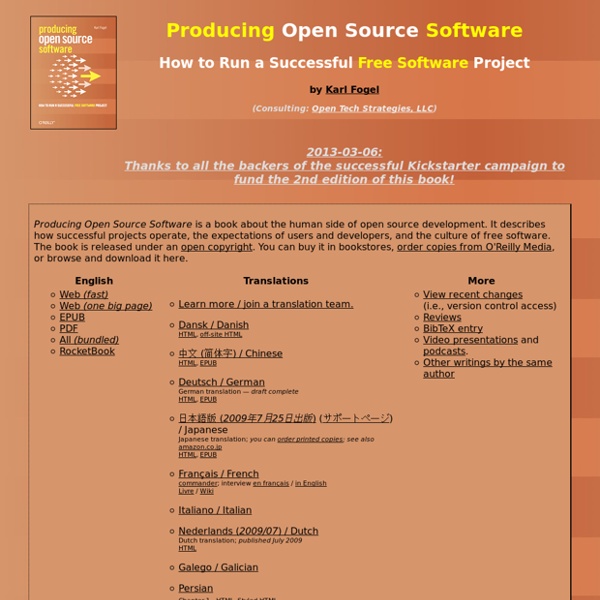



A handbook for the open source way, written the open source way Image by opensource.com Remember the Seinfeld episode where Kramer had the idea to make a coffee table book about coffee tables? I always thought that was a pretty elegant idea. Well, a few months ago, some of the smart folks on Red Hat's community architecture team had a similarly elegant idea: Write a book about building community the open source way... and write it with a community, the open source way. Brilliant. The book is entitled The Open Source Way: Creating and nurturing communities of contributors and you can access the current text here and the wiki for contributors here. I caught up with Karsten Wade, who is leading the project, to learn more. There have been other books written about community-building over the last few years, but I am not aware of any others that have been written by a community. Our team, Community Architecture, has a strategic community role in Red Hat, and part of that is learning, distilling, and sharing knowledge. Raptors, huh? Thanks.
Wikibooks The Art of Unix Programming AIX, AS/400, DB/2, OS/2, System/360, MVS, VM/CMS, and IBM PC are trademarks of IBM. Alpha, DEC, VAX, HP-UX, PDP, TOPS-10, TOPS-20, VMS, and VT-100 are trademarks of Compaq. Amiga and AmigaOS are trademarks of Amiga, Inc. The photograph of Ken and Dennis in Chapter 2 appears courtesy of Bell Labs/Lucent Technologies. The epigraph on the Portability chapter is from the Bell System Technical Journal, v57 #6 part 2 (July-Aug. 1978) pp. 2021-2048 and is reproduced with the permission of Bell Labs/Lucent Technologies. Software: Trac Three Book Recommendation Engines For Quick Book Searches Finding new books to read isn’t always easy. Looking at the size of libraries and some bookstores, it’s hardly surprising that there’s a lot of bad stuff circulating as well. Until recently, I limited myself to word of mouth and the tedious business of reading the back of every book on the shelves. How old-fashioned. Like StumbleUpon for websites, and Last.fm for music, there are so-called book recommendation engines as well, that suggest titles based on previous reads. For this article, we’ll focus on the ‘quick’ book recommendation engines, that skip the whole process of cataloguing and rating all your previous reads. The Book Seer The Book Seer is as simple as it gets. On the next page, you’ll be presented with two independent recommendation lists, so don’t be surprised if you see a duplicate title. The right side column is generated by LibraryThing‘s system, an online book cataloguing tool. Off-topic tip: Jonathan Strange and Mr. What Should I Read Next? WhichBook.net
Framabook - Livres libres sur le logiciel libre - Framasoft How to be a Programmer: A Short, Comprehe Debugging is the cornerstone of being a programmer. The first meaning of the verb to debug is to remove errors, but the meaning that really matters is to see into the execution of a program by examining it. A programmer that cannot debug effectively is blind. Idealists that think design, or analysis, or complexity theory, or whatnot, are more fundamental are not working programmers. Debugging is about the running of programs, not programs themselves. To get visibility into the execution of a program you must be able to execute the code and observe something about it. The common ways of looking into the ‘innards’ of an executing program can be categorized as: Using a debugging tool, Printlining --- Making a temporary modification to the program, typically adding lines that print information out, and Logging --- Creating a permanent window into the programs execution in the form of a log. Some beginners fear debugging when it requires modifying code. How to Understand Performance Problems
Projects/new-moinmoin-latex - Johannes MoinMoin standard formula: If f is entire (holomorphic on ) and without zeroes, for every closed curve the integral is zero. This is a red square: You can also jump to a red square below. We can also put it inline when using a macro. This works because you can only have a single line in a macro and thus a comment wouldn't make sense. HOWTO install (mostly courtesy of Bernhard Kast) Requirements: LaTeX (debian package tetex-bin) UTF-8 support files for LaTeX (debian package latex-ucs) dvipng (debian package dvipng) Actual Install: get the parser code (see code section) (use raw view) and save it as latex.py in your WikiPath/plugin/parser Beware that when you have many equations on a page, the browser has to make a request to the wiki for each page. Another set of installation instructions can be found at Requirements: #! error! Notes